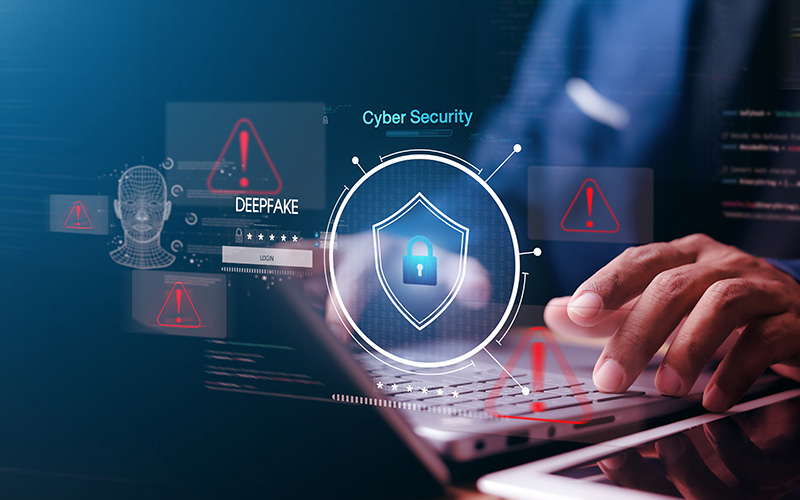The Deepfake-Fighting “Secret Sauce”: Combatting AI Fraud with AI
July 16, 2025

By Nicole Reyes, MVP, Risk Engagement, Velera
As the saying goes, “AI is as bad today as it’s ever going to get.” And it rings true: We see AI evolving every day in ever-emerging fraud schemes, and the analyses our teams conduct in defense are constantly becoming smarter and faster, too.
There will always be new and innovative ways for crafty fraudsters to get at our data, and the explosion of artificial intelligence (AI) has only accelerated the attacks. Conversations on internet chat platforms related to Deepfake fraud – the use of AI to create fraudulent conversations, images and videos – increased dramatically between 2023 and 2024, by about 644%. And, by the end of 2027, deepfake fraud is estimated to have an impact of $40 billion in stolen identities, lost data, hijacked savings and more in the United States alone.
Every day, as AI trains on more data, it continues to learn and become more sophisticated. As of today, generative AI (GenAI) only needs three seconds of your actual voice to be able to clone it into a deepfake. The red flags used to spot deepfakes are quickly becoming outdated as well.
Also, the availability and sophistication of AI have allowed for “DIY fraudsters.” You no longer need a technical background to be able to write malicious code, so even novice users can now perpetuate fraud.
While the increasing scope of AI fraud presents a large technical challenge for credit unions, it also poses a member trust issue, as well. So, what’s a fraud fighter to do?
The “Deepfake-Fighting Secret Sauce”
To protect our clients and their members in this new world of GenAI fraud, Velera fights back with those same weapons, using a layered approach that combines advanced technology, ongoing education and collaboration with external entities. We place our guardrails at every step in the transaction and reinforce it all with decades of human expertise.
The four categories that comprise what we think of as the “Deepfake-Fighting Secret Sauce” are:
- Identification strategies, such as account transaction-anomaly software that looks for “needles in a haystack” — rare signs of fraud hidden within millions of routine transactions — as well as multi-factor authentication (MFA).
- Enhancement strategies, such as constantly reexamining verification protocols and strengthening those wherever possible.
- Member-focused actions, such as education for employees and members.
- Technology advancements, such as biometric verification and real-time fraud monitoring systems.
Leading technology-based fraud safeguards draw data from across channels – the data captured is not just leveraged in one channel, and it’s not just used to validate the single engagement authorization. For example, an anomaly detected through MFA will add a red flag to our database, which will then contribute to fraud detection in real-time scoring, consumer-engaged fraud and even BIN-level attacks at the authorization level.
As this cross-channel data builds, you can see anomalies that you normally would not, and through that, we gain deep insight into potentially threatening behavioral patterns.
AI Fraud Fighting is Already in Place
One authentication product that is helping to fight AI fraud with AI is IDCheck, which leverages AI-trained models to validate the authenticity of an individual using both documentation and facial biometrics analysis. The model is trained on continually evolving deepfakes to detect the difference between a real picture and an AI-generated one.
IDCheck is simple to use: The member downloads the app, scans the QR code in the branch, uploads a selfie, shows identification to the teller and completes the transaction.
Another product that’s currently available is Intelligent Fraud Decisioning, a transactional fraud decisioning engine that can adapt quickly to fraud trends. Intelligent Fraud Decisioning uses cognitive AI, comprehensive data and enhanced analytics to significantly reduce fraud losses while also maximizing the consumer experience. Users can generate rule models from scratch or adapt existing models to emerging fraud patterns.
Each authorization that flows through Intelligent Fraud Decisioning goes through 100% real-time scoring. We also include our home-grown machine learning score right into the authorization stream: Every attempted fraud encounter, whether detected or missed, helps train the model to become more accurate and resilient.
While traditional fraud rule engines are great at analyzing individual velocities or card patterns, Intelligent Fraud Decisioning also offers BIN-level monitoring so it can look at spikes across an entire BIN or portfolio.
AI excels at analyzing data, identifying patterns and monitoring account activity. Its ability to constantly learn and improve allows it to predict potential threats, detect fraudulent transactions and prevent money laundering. So, while fraudsters get better every day, we get better, too.
To learn more about Velera and the solutions they offer, connect with the GoWest Solutions Team today.
Posted in GoWest Solutions, Top Headlines.


















